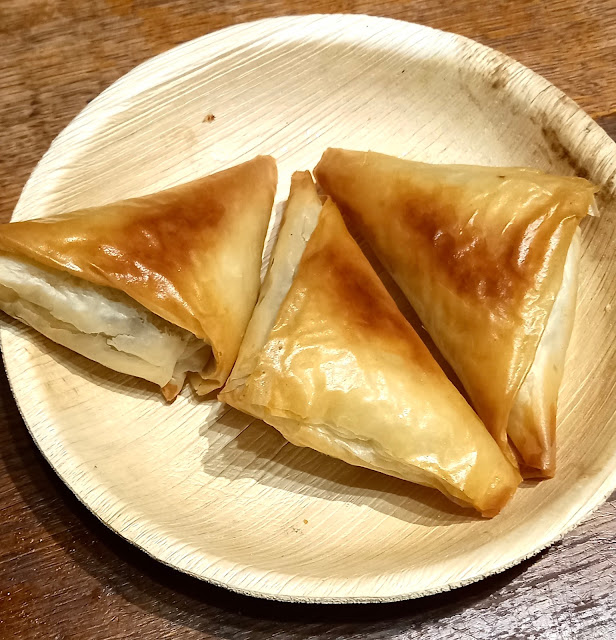Curry puffs: how a Portuguese snack arrived in Southeast Asia in the 1500s and became a hit across the region
Samosas need no introduction! We all love that flaky, crispy and flavoursome pastry filled with spicy potato or meat filling. But alas most of us think it is extremely difficult to replicate restaurant-like crispy samosas at home. However, there are a few easy ways to make restaurant-like crispy samosas at home.
This moorish snack is packed with spice, but should the pastry be chewy and robust or crisp and flaky? And which folding technique is best?
But before you try making a batch, thinking the samosa is an invention of India, take a look at its history. In Goa (India) and Portugal, where they are a common snack, samosas are an integral part of the cuisine, they are known as chamuças. They are usually filled with chicken, beef, pork, lamb or vegetables, and generally served so hot you have to blow on them to make them palatable.
Portuguese spice traders introduced the empada – a kind of pie – to Southeast Asia in the 1500s
It spread along the trading routes, and most countries in the region now have their own version.
 |
Can´t wait for that chamuca to cool down !! photo©elephantsandthecoconuttrees.com |
Having found its way to India through these trading routes, these small, crisp vegetable or mince-filled triangles became easy to make around the campfire during overnight stops, then conveniently packed into saddlebags of the Muslim merchants as snacks for the next day's journey. According to the “The Oxford Companion to Food” the Indian samosa is "merely the best known of an entire family of stuffed pastries or dumplings popular from Egypt and Zanzibar to Central Asia and West China". Arab cookery books of the 10th and 13th Centuries refer to the pastries as sanbusak (the pronunciation still current in Egypt, Syria, & Lebanon), sanbusaq or sanbusaj, all reflecting the early medieval form of the Persian word: sanbosag. Claudia Roden (1968) quotes a poem by Ishaq ibn Ibrahim-al-Mausili (9th Century) praising the sanbusaj.
Oil in Dough- The quantity of oil added to the dough before kneading determines the flakiness of the samosa. If too little oil is added, it may harden the crust of the samosas.
Texture- The dough needs to be hard and stiff, and soft dough does not work for samosa. You must add water only if required. Tiny air bubbles may form if the dough has too much moisture.
Kneading & Resting- You must remember not to over-knead the dough. After letting it rest for half an hour, knead it for no more than 3-4 minutes. It should not turn soft.
Rolling- If you roll the dough too thin, the samosas will break while frying. If you roll it too thick, the crusty samosa will hold too much oil and the centre won’t cook.
Frying- Do NOT fry samosas in extremely hot oil. Samosas are best fried in moderately hot oil. Check the oil by dropping in a piece of dough, it should not sizzle immediately. Bubbles should appear only after a few seconds. Keep the heat on low.
Samosas are traditionally made from a fairly sturdy pastry, presumably because, like the British pasty, this eminently portable snack was designed to travel well. Most people use plain flour, I have tried every which way and my best results to date were using phyllo pastry. Not authentic I know but proucing a beautifully crisp result.
 |
| The mainstay of any office party or buffet |
VEGETABLE FILLING
- 1 tbsp vegetable oil
- 1 onion, finely chopped
- 2 garlic cloves, crushed
1 potato (about 150g) finely diced- 1 carrot (about 100g) finely diced
- 100g frozen peas
- 2 tsp curry powder or your own spices according to taste
- 100ml vegetable stock
Unroll the pastry and cover with cling film and a damp tea towel. Peel off one piece and keep the rest covered so that it doesn't dry out. Lay the pastry sheet flat on a clean surface and brush with melted butter. Fold in one third of the pastry lengthways towards the middle. Brush again with the butter and fold in the other side to make a long triple-layered strip.
Place one rounded teaspoon of the filling mixture at one end of the strip, leaving a 2cm/1in border. Take the right corner and fold diagonally to the left, enclosing the filling and forming a triangle. Fold again along the upper crease of the triangle. Keep folding in this way until you reach the end of the strip. Brush the outer surface with more butter. Place onto a baking sheet and cover while you make the rest of the samosas. Sprinkle over a few sesame seeds, if using.
Bake in the centre of the oven for 30-35 minutes, or until golden and crisp, turning halfway through the cooking time.
To serve, place the samosas onto a large serving plate with a bowlful of chutney.



Comments
Post a Comment